Being in control of progress and expected cost levels are basic deliverables for a professional project manager. There are many ways to obtain such progress information, but the requirement is often that the information is quantitative, verifiable and non-reversible.
The most well-known method is "Earned Value" (EV), a simple and powerful method that requires little information to say much about the status of the project. EV has a strained reputation – not because of its complexity, but because a proper schedule needs to be in place. Unfortunately, most people limit themselves to saying something about where they are,but forget to say anything about where they should be.
To accomplish this, the project manager must take on the task of being a scheduler, and unfortunately task lists are not enough in Excel. Here you have to come up with MS-Project or similar tools. The following illustration shows the context in which the project manager should be able to present:
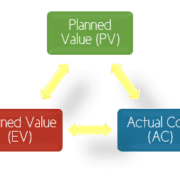
Unfortunately, many project managers do not fully use the opportunities provided by EV, due to the fact that the customer does not know the method and therefore does not set this as a requirement. As a professional, it is the project manager's task to communicate such insight to the customer, to ensure that the customer has the best possible decision basis at all times to manage the project in the direction that the customer is best served by.
In addition, one can advantageously present ev over time as an S-curve:
- S-curves are primarily a visual management tool for the steering group that provides a basis for directing the necessary questions to the project manager as well as seeing trends in the project without having to read anything
- S-curves are used by the project manager to communicate status and quality, as well as ensure their own plan early in the project
To provide maximum overview, Progress and Hour consumption should be presented on separate axis:
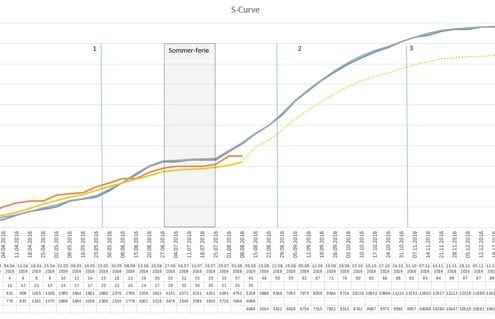
A project manager must always make up his mind about the scope of the project manager's delivery, or the questions he wants answered. Each of these has requirements for different data and methodological basis. For example, you can't create an S-curve without a proper schedule in place, and you can't calculate "Earned Schedule" without having an S curve as a methodical background material:
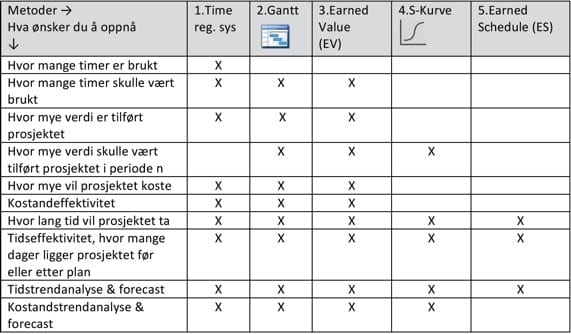
In other words, it is a clear information pyramid you work for as project manager:
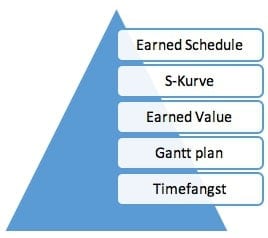
The biggest sin for a project manager is to report the wrong status to the PMO or steering group due to ignorance of the subject he is set to serve. Unfortunately, project managers often get to report EV values (e.g. EAC) without having a schedule as a basis. A classic mistake is to report status based on what you are familiar with (such as hourly consumption and total budget), and unfortunately you often see that project managers do not report progress as "Added value" in the project, but how much has been spent on the budget.
Why isn't Earned Value sufficient?
EV consists of a whole range of indicators and indices that professional project managers use in planning and communication with pmo and steering group, but not everything is perfect:
- Schedule Performance Index (SPI) will always be 1.0 at the end of the project and is unusable as an index after the project is 50% complete
- A - Schedule Variance will always be 0 at the end of the project. Nor is this a valuable indicator to steer by in the event of major delays
In other words; Earned Value is not fit to say anything about TIME, only about COSTS. Earned Schedule (ES) does not replace EV, but aims to provide a complete picture together with EV:
- "Earned Schedule" tells something about the value of the deviation from planned progress in the number of days or periods called ES, and is expressed in the reporting period the project is in accordance with the current progress. If scheduled ES = 16 (current reporting period) and actual ES = 15.4, you are 3 days behind schedule.
- «Earned Schedule» gir en reell SPI index, som kalles SPI(t). 1 = på plan, >1 = bra, <1 = ikke bra
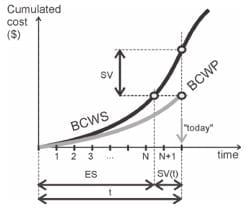
Unfortunately, it is not the lack of a proper template or description of a method that is the main challenge, but the understanding of the method. An enlightened steering group that has a sense of control is a satisfied steering group. This gives an even more satisfied project manager who can use the time for what really adds value: to steer the project in the direction that provides the greatest value for the customer.
Solutions in MS-Project
The practicality of using MS-Project as a basis for solving the problem is that all answers and analyses are already there. The only thing that needs to be done is to extract the information you need.
You can go to great lengths to start with the formulas in the link at the bottom of the article and build a solution to this. Or you can use an existing MS-Project template (free) and get training on how to use and further develop it to meet YOUR needs and make you better in your organization. Save time and money by getting in touch.
More information: http://easyrisk.eu/from_earned_value.asp


